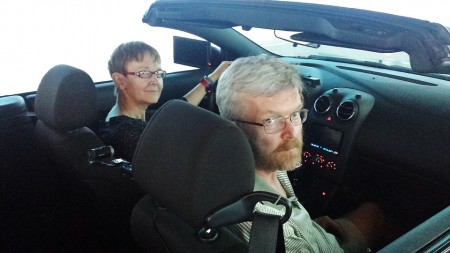
Psychology professor Lana Trick hasn’t driven since grad school. But the prospect of saving lives, and preventing injury and costly damage on the roads, will fuel her studies of motorists’ behaviour and performance with a state-of-the-art driving simulator unveiled this week at the University of Guelph.
A cross-campus research team of psychologists, computer scientists and engineers will inaugurate the new driving simulator, considered unrivalled by any other university in Canada.
Equipped with a new simulator vehicle and motion capture system, the DRIVE Lab (Driving Research in Virtual Environments) is intended to help strengthen U of G’s leading research role in road and motorist safety.
The equipment was purchased with grants worth a total of $468,000 from the Canada Foundation of Innovation and provincial funding.
Not only are vehicle crashes a leading cause of injury and death, but they also cost taxpayers billions of dollars every year in health and social welfare expenses, says Trick.
“I know so many people who have had their lives changed by collisions,” she says. “It seems almost everyone in some way or another has been touched.” Referring to a friend involved in a car crash just after graduating, she says, “It killed his fiancée and gave him injuries that made it impossible for him to do the job he had trained so many years for.”
Along with computer scientist Blair Nonnecke and engineer Michele Oliver, she will run simulations designed to help improve traffic laws and regulations, enable carmakers to design safer vehicles, build better roads and even provide useful information to drug companies.
The new equipment — a specially outfitted Pontiac G6 hardtop convertible — replaces the lab’s first driving simulator installed in 2005.
Occupying ground-floor space in the Thornbrough Building, the simulator includes viewing screens that project a wraparound, virtual-reality driving environment. Linking to the Google mapping function will allow the screens to project real-live scenarios, such as driving around downtown Guelph.
The new equipment includes a motion-capture system of cameras for observing subjects’ activities, including their use of in-vehicle devices and equipment.
Outside of testing facilities run by carmakers, the combination of simulator and motion capture technology in the DRIVE Lab is unmatched in Canada, says Nonnecke, School of Computer Science.
He and Trick will use the new technology to study driving behaviour, in-vehicle devices and self-driving cars.
The equipment allows researchers to challenge subjects with road hazards, from inattentive pedestrians and poor weather and visibility, to heavy traffic and reckless behaviour by other motorists.
It also permits the team to gauge in-car distractions such as GPS systems, passengers and even the driver’s emotional state. Research suggests three out of four crashes involve lack of attention, says Trick.
“Driving simulators allow drivers to be tested in the dangerous situations that produce collisions without putting lives in peril. Simulators permit close control of experimental conditions that are essential for research on drivers at risk.”
Over the past decade, the team has studied numerous topics, including at-risk older and novice drivers, use of cellphones and texting, pedestrian crosswalks and effects of medications on drivers with ADHD.
Some studies are contracted by clients, including the Ontario Traffic Council, the Ontario Ministry of Transportation (OMT), and insurance and drug companies.
For one OMT study, Guelph researchers recommended appropriate signage to alert drivers to a highway roundabout in Welland, Ont.

Earlier, the team won a publication award for a paper on a “moose detector” designed to warn drivers about large animals on the road. Another project looked at a reward-based video game system to teach appropriate following distance to novice drivers. An additional study described a way to use vestibular stimulation to reduce symptoms of simulator sickness, which causes dizziness and nausea in some people in virtual-reality scenarios.
Motorists’ behaviour — especially attention and distraction — interests Trick, who gets around on foot and by using public transit. “I am especially intrigued by the mystery of why people sometimes drive straight into things they are looking at.”
Nonnecke studies human-computer interactions, including the recent rise of in-vehicle safety systems, which he says range in quality “from good to terrible.”
“I’m fascinated by how people interact with technology generally,” he says.
In the first-ever fatality involving a self-driving car, a motorist in Florida died in a crash with a transport truck. Nonnecke plans to study problems in self-driving cars, including how well drivers switch between manual and automated modes.
Along the way, they attracted a third team member.
In her nearby engineering lab, Oliver uses a hexapod robot and motion capture cameras to study biomechanics in operators of heavy equipment. Cab and vehicle design can lead to repetitive strain and musculoskeletal disorders, she says.
New high-tech cameras mounted above the new convertible in the DRIVE lab will provide a bird’s-eye view of subjects’ movements.
Oliver says motion capture information may be coupled with electromyography equipment that records electrical activity in muscles. That will allow researchers to track subjects’ movements such as braking and steering as they react to road hazards.
Cameras can also track subjects’ eye movements. All of that information is useful for car companies designing systems and for forensic engineers reconstructing collisions for court cases.
The new simulator contains a more flexible display system. Even without an engine, the car mimics engine sounds. Computers allow operators to simulate road vibrations to make driving more life-like.
“We’re a nice blend of skills,” says Oliver of the research team. “We want to make driving safer. To make driving safer, you need to understand what’s unsafe about driving, and that can best be understood from a multidisciplinary perspective.”